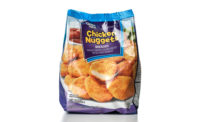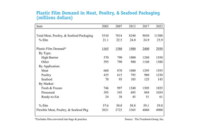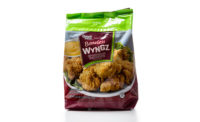The fresh-meat packaging market is projected to grow at a 2.3 percent compound annual growth rate (CAGR) to reach $2.47 billion in 2026, according to a report by Transparency Market Research, in Albany, N.Y. Much of this growth will be for products in flexible packaging due to the rising demand for modified-atmosphere packaging (MAP), ready-to-eat snacks and vacuum skin packaging (VSP).
In fact, the report predicts VSP will drive market growth and capture a 32 percent share of total revenue by 2026. Demand for VSP, which is divided between form-fill-seal and fill-seal options, is driven by increasing sales of chicken and fresh seafood products. Advantages of VSP include product differentiation and color preservation.
The growing popularity of meat snacks also is expected to spur market growth. A study by London-based Technavio, forecasts an 8 percent CAGR between 2018 and 2022 for the global meat snacks market. This growth will stem primarily from new products and innovative packaging. With growing demand for MAP, ready-to-eat snacks and VSP, use of flexible packaging for primary and secondary (multipack) packaging continues to rise.
The growing number of meat, poultry and seafood products in flexible packaging benefit from material innovations such as tenter frame, biaxially oriented polyethylene (TF-BOPE). This material offers higher mechanical properties and rigidity along with better optics and printing performance. Compared with traditional PE, TF-BOPE exhibits up to 80 percent less haze, double the impact strength and tensile modulus, and triple the puncture resistance and tensile strength.
Although flexible packaging offers sustainability advantages over rigid packaging due to its lighter weight, reduced volume and lower transportation emissions, material development efforts continue to focus on more sustainable structures. One example is a vacuum skin film capable of sealing at lower temperatures (50 C), thus reducing energy consumption. Lower temperature processing of vacuum skin packs also results in more gentle handling and can have a positive effect on shelf life, reportedly up to double the timeframe delivered by MAP. Longer shelf life minimizes shrink at the retail level and food waste at the consumer level and enables entry into more geographically distant markets. High-clarity, glossy skin film also delivers shelf impact. In addition, the soft, yet puncture-resistant film accommodates the sharp edges encountered with bone-in products and shellfish.
Sustainability may be enhanced further by resource-conserving thin films, designs that minimize the use of plastic and structures that contain renewable content or are more likely to be recycled. Enhanced recyclability can be achieved with the use of polyolefin resins for formable base film and associated lidstock and packaging designs that simplify the separation of paperboard and plastic components.
Form-fill-seal equipment innovations also focus on consumer-pleasing and productivity-enhancing features. The latest technology makes it possible for existing vertical form-fill-seal equipment to produce eye-catching, functional stand-up pouches with minimal modification and capital investment. Productivity-enhancing features include sanitary design, easy operation, quick changeover, remote control and diagnostics and minimal maintenance requirements.
Flexibility also is a sought-after attribute. As a result, many machines can handle VSP, MAP and vacuum packaging and are designed in modules to simplify post-installation modification and expansion. Sustainability remains a consideration for equipment as well as materials with designs that reduce energy consumption via components like energy-saving drives. NP
Sources:
- Transparent Market Research, Fresh Meat, Packaging Market (Packaging Technology Type - Modified Atmosphere Packaging (MAP), Vacuum Skin Packaging (VSP) and Vacuum Thermoformed Packaging (VTP); Material Type — PE, PP, BOPP, EVOH, PVC, and PA; Meat Type — Beef, Pork, Poultry and Seafood) — Global Industry Analysis, Size, Share, Growth, Trends and Forecast 2016 – 2026, market study, March 20, 2019.
- Technavio, Global Meat Snacks Market 2018-2022 press release, July 23, 2018.







